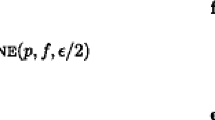Abstract
The flow circulation sharing problem is defined as a network flow circulation problem with a maximin objective function. The arcs in the network are partitioned into regular arcs and tradeoff arcs where each tradeoff arc has a non-decreasing tradeoff function associated with it. All arcs have lower and upper bounds on their flow while the value of the smallest tradeoff function is maximized. The model is useful in equitable resource allocation problems over time which is illustrated in a coal strike example and a submarine assignment example. Some properties including optimality conditions are developed. Each cut in the network defines a knapsack sharing problem which leads to an optimality condition similar to the max flow/min cut theorem. An efficient algorithm for both the continuous and integer versions of the flow circulation sharing problem is developed and computational experience given. In addition, efficient algorithms are developed for problems where some of the arcs have infinite flow upper bounds.
Similar content being viewed by others
References
R.S. Barr, F. Glover and D. Klingman, “An improved version of the out-of-kilter method and a comparative study of computer codes”,Mathematical Programming 7 (1974) 60–86.
M.S. Bazaraa and J.J. Jarvis,Linear programming and network flows (Wiley, New York, 1977).
C. Berge,Graphs and hypergraphs (North-Holland, Amsterdam, 1973).
T.A. Bray and C. Witzgall, “Algorithm 336. NETFLOW”,Communications of the ACM 11 (1968) 631.
J.R. Brown, “The sharing problem”,Operations Research 27 (1979) 324–340.
J.R. Brown, “The knapsack sharing problem”,Operations Research 27 (1979) 341–355.
J.R. Brown, “Planning via sharing”, mimeographed (1978).
L.R. Ford and D.R. Fulkerson,Flows in networks (Princeton University Press, Princeton, NJ, 1962).
D.R. Fulkerson, “An out-of-kilter method for minimal-cost flow problems”,Journal of the Society for Industrial and Applied Mathematics 9 (1961) 18–27.
A.J. Hoffman, “Some recent applications of the theory of linear inequalities to extremal combinatorial analysis”, in: R. Bellman and M. Hall Jr., eds.,Proceedings of symposia in applied mathematics. Volume X, Combinatorial analysis (American Mathematical Society, Providence. RI. 1960) pp. 113–127.
D.B. Johnson, “Finding all the elementary circuits of a directed graph”,SIAM Journal on Computing 4 (1975) 77–84.
D.E. Knuth,The art of computer programming, volume 1 (Addison-Wesley, Reading, MA, 1973).
E.L. Lawler,Combinatorial optimization: networks and matroids (Holt. Rinehart and Winston, New York, 1976).
P. Mateti and N. Deo, “On algorithms for enumerating all circuits of a graph”,SIAM Journal on Computing 5 (1976) 90–99.
M. Simmonard,Linear programming (Prentice-Hall, Englewood Cliffs. NJ. 1966).
Author information
Authors and Affiliations
Rights and permissions
About this article
Cite this article
Brown, J.R. The flow circulation sharing problem. Mathematical Programming 25, 199–227 (1983). https://doi.org/10.1007/BF02591771
Received:
Revised:
Issue Date:
DOI: https://doi.org/10.1007/BF02591771




